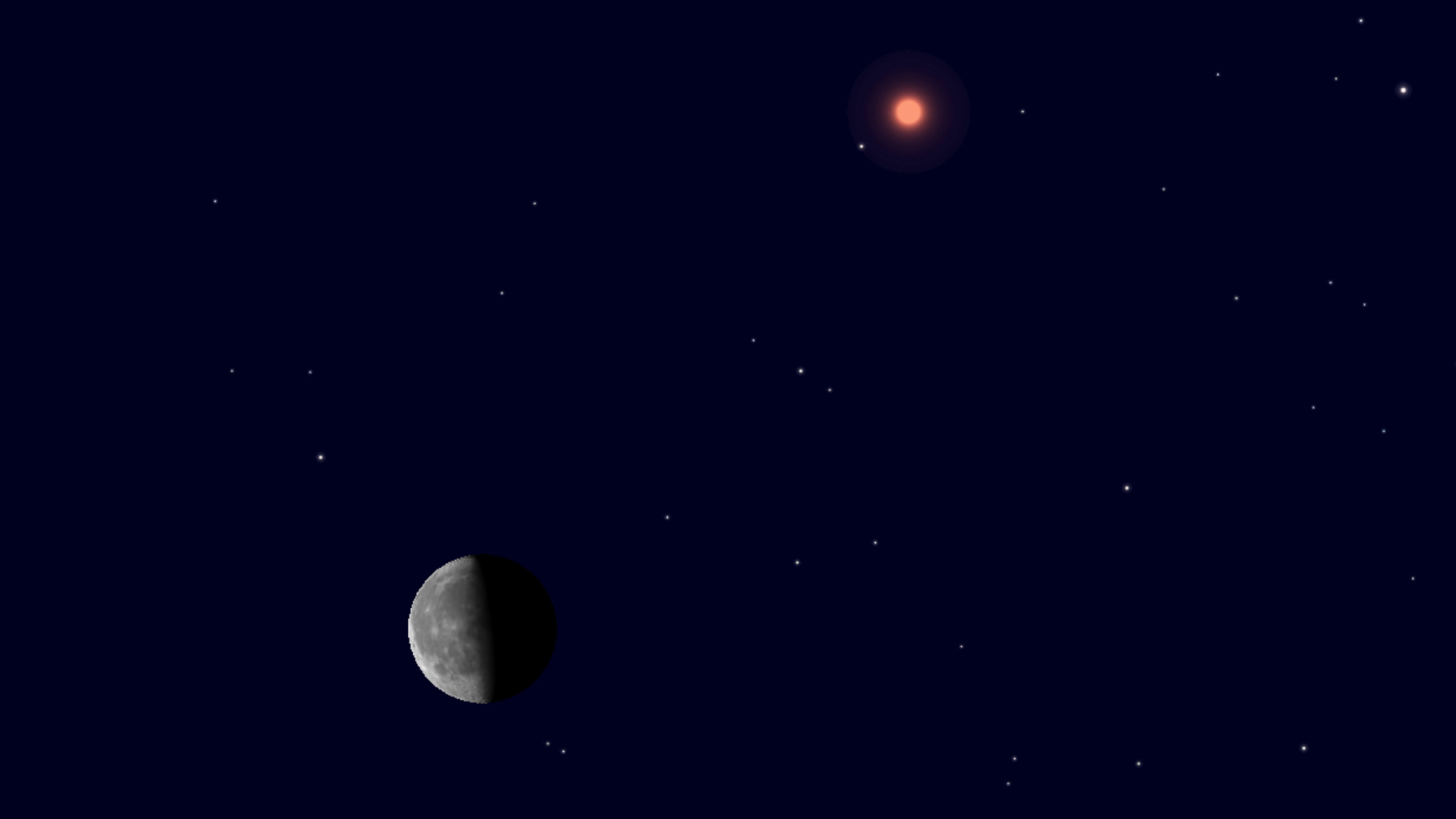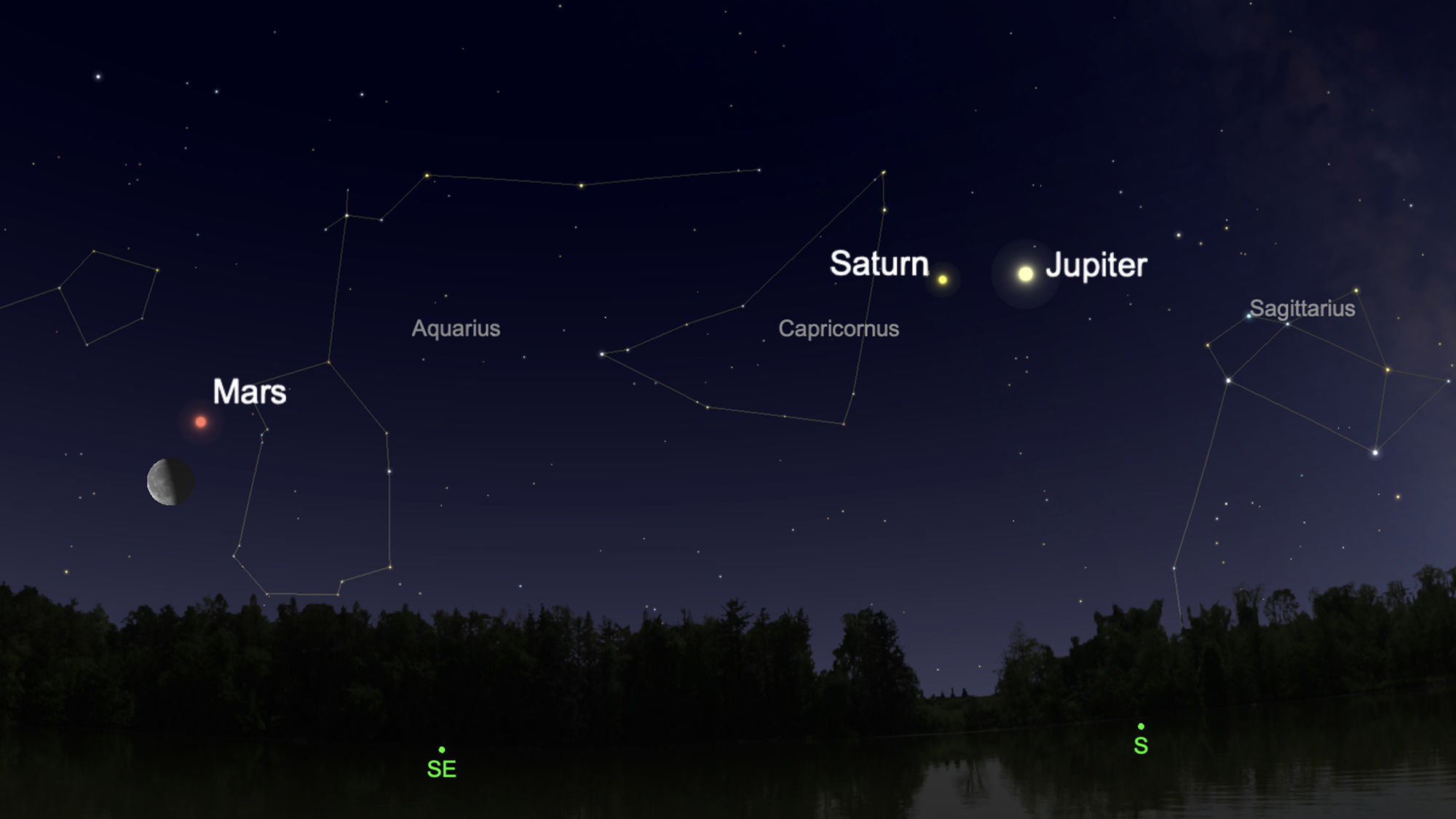See Mars rise with the 'half' moon early Saturday morning
Early risers will be rewarded.

The last-quarter moon will make a close approach to the Red Planet in the predawn sky on Saturday (June 13), providing a celestial treat for early birds and night owls.
If you're up before the sun on Saturday morning, look to the southeast horizon to find Mars snuggled up close to the waning moon, which reaches last-quarter phase that morning at 2:24 a.m. EDT (0624 GMT).
Related: Moon phases
Mars and the moon will be in conjunction — meaning they share the same celestial longitude — tonight (June 12) at 7:55 p.m. EDT (2355 GMT), according to the skywatching site In-The-Sky.org. But for skywatchers in the United States, the pair won't be visible at that time. In New York City, for example, Mars rises on Saturday at 1:16 a.m. local time, and the moon rises about 20 minutes later.
Related: Best night sky events of June 2020 (stargazing maps)

Even if you aren't able to witness the moment of their conjunction, the moon and Mars will still put on a great show when they rise in the morning. The 21-day-old moon will be less than 3 degrees to the south of Mars, and both will be in the constellation of Aquarius, the water bearer. (Reminder: Your clenched fist held at arm's length covers about 10 degrees of sky.)
They'll start to fade out of view when dawn breaks, so to get the best view, you'll want to look before sunrise. In New York City, the sun rises at 5:24 a.m. local time on Saturday.
Get the Space.com Newsletter
Breaking space news, the latest updates on rocket launches, skywatching events and more!
Mars will be shining at a magnitude of -0.2, or nearly as bright as Alpha Centauri, the third-brightest star in Earth's sky, not including the sun. (Magnitude is a logarithmic scale of brightness used by astronomers, with negative numbers denoting brighter objects.)
The Red Planet will continue to brighten over the coming months, until Oct. 13, when it reaches opposition — the point in its orbit where it is directly opposite the sun in Earth's sky. By then it will have reached a magnitude of -2.7, which is more than three times brighter than Sirius, the brightest star in the night sky.
Editor's note: If you have an amazing night sky photo or video that you'd like to share for a possible story or image gallery, please contact managing editor Tariq Malik at spacephotos@space.com.
- When, where and how to see the planets in the 2020 night sky
- 'Strawberry Moon' lunar eclipse treats skywatchers around the world
- Watch Mars 'sneak' behind the crescent moon in these amazing views (video)
Email Hanneke Weitering at hweitering@space.com or follow her @hannekescience. Follow us on Twitter @Spacedotcom and on Facebook.
OFFER: Save 45% on 'All About Space' 'How it Works' and 'All About History'!
For a limited time, you can take out a digital subscription to any of our best-selling science magazines for just $2.38 per month, or 45% off the standard price for the first three months.
Join our Space Forums to keep talking space on the latest missions, night sky and more! And if you have a news tip, correction or comment, let us know at: community@space.com.

Hanneke Weitering is a multimedia journalist in the Pacific Northwest reporting on the future of aviation at FutureFlight.aero and Aviation International News and was previously the Editor for Spaceflight and Astronomy news here at Space.com. As an editor with over 10 years of experience in science journalism she has previously written for Scholastic Classroom Magazines, MedPage Today and The Joint Institute for Computational Sciences at Oak Ridge National Laboratory. After studying physics at the University of Tennessee in her hometown of Knoxville, she earned her graduate degree in Science, Health and Environmental Reporting (SHERP) from New York University. Hanneke joined the Space.com team in 2016 as a staff writer and producer, covering topics including spaceflight and astronomy. She currently lives in Seattle, home of the Space Needle, with her cat and two snakes. In her spare time, Hanneke enjoys exploring the Rocky Mountains, basking in nature and looking for dark skies to gaze at the cosmos.
-
rod FYI, I was not out early this morning but did enjoy some views of the Last Quarter Moon in the morning sky.Reply
This morning (0800-0900 EDT), I enjoyed telescope views of sunspot AR2765, slowly moving across the Sun since I first observed on 06-Jun and reported earlier on spaceweather.com. I viewed the Last Quarter Moon in the morning sky too using my 10x50 binoculars, Clavius crater area distinct along the terminator line with other craters. The sunspot region and lighter plage very distinct at 71x using yellow and red filters with my glass, white light solar filter. Great, clear skies here today :)---Rod










